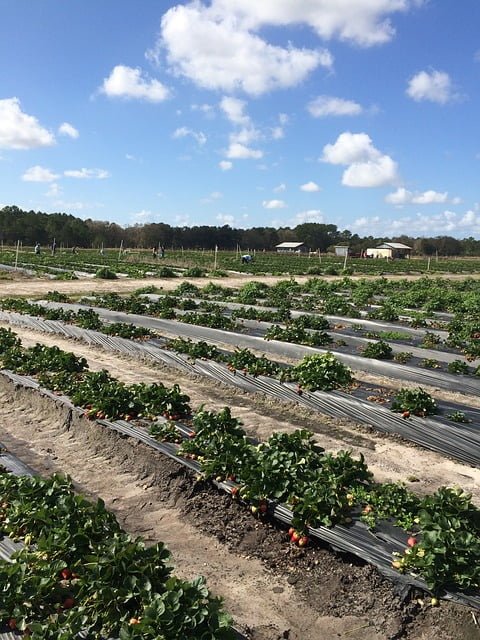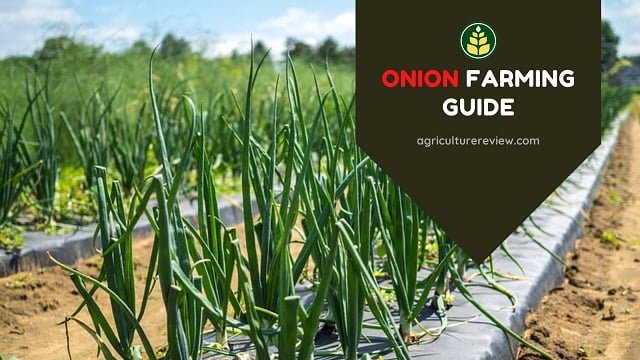Are you willing to learn or start strawberry farming, if yes then you are on the right page. In this article Agriculture Review is going to discuss the methods of strawberry farming, reading this article will help you to earn higher yields and income from your strawberry farm because of the accurate knowledge.
There is huge scope of strawberry farming in the world because of huge demand of strawberries in the global market. Mainly during the summer months in various countries the demand increases but the supply remains low, hence the price in the market increases.
The global market of strawberry is still increasing by 5% per year. According to the research by IndexBox the global strawberry market in the year 2016 was around 9.2 Million tonnes.
And the total market cost was estimated around $15.9 Billion and this is still increasing. So you can imagine that if you want to start strawberry farming there is a huge market open and waiting for you to jump in and earn profits.
Table of Contents
Botanical Classification
Botanical name of strawberry: Fragaria ananassa
Family: Rosaceae
Order: Rosales
Class: Magnopliopsida
Division: Magnoliophyta
Chromosome number: 2n = 56
Origin of Strawberry
- The exact origin of strawberry is still not clear but the cultivated variety of strawberry is believed to be originated in Europe in the 18th Century.
- In the 19th Century various countries started growing their own varieties of strawberry that are adopted to their environment with the help of crossing and hybridization.
Geographical Distribution
- Strawberry farming is done mainly in China, United States of America, Mexico, Egypt, Turkey, Spain, Russia, Poland, South Korea, Japan, etc.
- India is not a major strawberry cultivating country but the market demand is high and that’s why many farmers are adopting strawberry farming to get higher returns from their farm.
- In India, strawberry farming is mainly practiced in Nainital, Dehradun, Mahabaleshwar, Bangalore, Kalimpong, Kashmir Valley, etc. Nowadays strawberry is also being cultivated in states like Haryana and Bihar.
Area and Distribution
- The total production of strawberry in the world is 9,125,913 tonnes per year.
- China is the leading producer of strawberry in the world, it produces 3,801,865 tonnes volume production per year according to AtlasBig.com. This is followed by United States of America that produces 1,420,570 tonnes of strawberry per year, Mexico, Egypt, Turkey, etc.
- About 57% of the global strawberry production is contributed by China and United States of America. India is not a major strawberry cultivating country and no such clear data is present on area and production of strawberry in India.
Strawberry Farming Guide

Soil requirements
For cultivating strawberry successfully slightly acidic, well drained, loamy soil that is rich in organic matter is considered ideal. If the soil pH is in the range of 5.7 to 6.5 then it is very appropriate, high pH values than the ideal range can cause poor root formation.
Before cultivating strawberry in your field you should get your soil tested for these parameters. If the calcium level in the soil is found high than the required then it can cause yellowing of leaves.
Runner formation is found better in light soil that are rich in organic matter. If the soil of your farm is found to be alkaline then you should avoid cultivating strawberry in that farm. Before starting plantation do check for harmful nematodes, if they are present then avoid plantation.
Do not cultivate strawberry on the same land again and again and also on the land that was previously used for cultivating potato, raspberry, pepper, tomato, and eggplant. Keep changing the crop after few years in the field to get good yield from the same field.
In colder region, mulching is done to preserve adequate moisture and prevent roots from the frost because the strawberry has fibrous root system that grows only to 15 centimetres deep.
Climate & Temperature
Here comes the main thing that is required for successful growth and development of strawberry flowering and fruit formation. If you want to get successful in strawberry farming then this is the major step i.e. selecting the cultivar according to the climate and temperature.
Strawberry is categorized into two groups depending on the duration of the light period:
- The overbearing variety that can develop flowers both in long and short light periods.
- The commercial variety that develop flower buds only during short light periods.
This means that the duration of light can affect the flower formation of the cultivar that you may be growing, so before selecting the variety or cultivar make sure that it is suitable for your region.
Strawberry grows majorly in temperate climate but few varieties can also survive and grow in subtropical climate. As strawberry is a short day day plant so it becomes necessary that the plant gets sunlight exposure of less than 8 hours for ten days to initiate flowering.
Strawberry variety that grows in temperate regions goes dormant in winter season which means that the growth of the plant get stopped during winters. But subtropical variety shows very little growth during the winter season.
Strawberry plant propagates through runners that are formed after blooming season and are planted in the months of September to October in hilly regions of India.
Varieties of strawberry
There is a huge number of varieties that are present in the market but selecting the right one for your farm is very necessary. Well different countries can have profitable varieties that are developed through successful breeding practices in your region or country.
It is better to connect with local agriculture institutions to find out the variety that can be grown in your region with maximum efficiency. In India for hilly regions you can grow Royal sovereign, Dilpasand and Srinagar.
You can also select Torrey, Toiga, and Solana variety that are introduced from California and are found more successful in hilly regions of India. Pusa Early dwarf variety is found to be successful in northern plains of India.
If you want to grow and cultivate in Bangalore or Mahabaleshwar regions of India then you can grow Bangalore variety of strawberry in your farm.
Premier Florida-90, Blackmore, Missionary, Klonmore and Klondike are the varieties of United States of America that are found to be successful in sub tropical areas that have warm climate.
Few more varieties of strawberry are Sweet Charlie, Tristar, Chandler, Camarosa, etc.
Propagation of strawberry
Strawberry can be successfully propagated through runner that are formed after blooming. Plant bloom and flowers during spring season and then the temperature starts rising, this leads to vegetative growth of the plants and runner formation.
If the mother plant is used for propagation purposes and sell the baby plants in the market then fruits are not allowed to set on the plant for this purpose. If you are a farmer then you can also earn good amount of profit by selling seedlings in the farmer’s market.
Those plants that have a healthy and good root system can be used to produce new plants. Each plant can produce 12 to 18 runners if the proper care is provided.
Field preparation
For the cultivation of strawberry, field should be prepared by deep ploughing followed by harrowing before plantation. At the same time you should add organic manure in required amount in the field.
You can plant strawberries on flat beds, raised beds, or in the form of matted rows or hill rows. You can prepare raised beds of 4 x 3 metres or 4 x 4 metres. The row to row distance should be 60 to 70 centimetres and plant to plant distance can be 45 centimetres.
You can also apply mulch layer of black and silver mulching paper to protect your roots from frost or cold injury, maintaining adequate moisture, preventing fruit from decaying, and weed control in the field.
Straw mulch can also be use in place of black and silver mulching paper. They are also proved to be successful and are used commonly in many farms.
The ideal time for strawberry plantation is in the months of September to October, however you should always find out the plantation time of the cultivar selected by you for better performance.
Manures & Fertilizers
Strawberry can grow well in moderate amount of nitrogen in the soil. At the beginning you can add 20 to 40 tonnes of Farm Yard Manure per hectare, exact amount can differ according to fertility of the soil.
If you want to grow strawberry inorganically then you can add 80 Kg Nitrogen, 40 Kg Phosphorus and 60 Kg Potassium in one hectare land. You should avoid adding Nitrogen during flowering and fruiting stages of the plant.
You can add 12 grams of micronutrients once after every week in 500 square per metres of land. Avoid adding complete doze of organic as well as inorganic fertilizers at once.
You can apply half doze of fertilizers at the time plantation and other half before blooming period. In case you are growing only organically without using any chemical fertilizers then you can also use Bulk organic manures like Vermicompost, cow dung manure or any other bulky manure.
Recently, waste decomposer and jeevamrut have been found very useful in organic farming and they can be used for the cultivation of strawberry. If you want to learn the benefits and process of using these biofertilizers then you can visit these links:
READ MORE: WASTE DECOMPOSER: BENEFITS AND PROCESS TO MAKE AND USE
READ MORE: JEEVAMRUT: BENEFITS AND PROCESS TO MAKE AND USE
Irrigation
Both waterlogging and drought conditions should be avoided in the field because strawberry has shallow root system that can get affected due to draught and in water logging condition root rot can occur.
First irrigation should be given immediately after the plantation, this should continue for few days till the new plants get well established in the field. Further the irrigation will depend on the weather and climate. Before irrigating your field ensure proper drainage channels to remove excess water.
During September to October, if there is no rain then irrigation should be given twice a week. During summers frequent and light irrigation will be appropriate.
During early winters irrigating the once a week is good but if the average temperature remains below 16 degree celcius then irrigate once every fortnight.
If you have a good budget and wants to save your time then you can adopt drip irrigation systems in your field for strawberry farming. You can have 1 to 2 lateral lines of 16 mm that have dripper after every 30 centimetres. The ideal discharge rate for this setup is 2 to 4 litres per hour.
Weeding and Hoeing
Weeds can cause serious loss in total yield that’s why controlling weeds become a very necessary part for cultivating strawberry. Weeding in strawberry fields can be done through hands, i.e. hand weeding in which weeds are picked with the help of hands.
Light hoeing is required time to time to control weed growth in the field. You can use small weeding machines to remove weeds easily from your field. First weeding should be done 30 days after plantation.
Second weeding can be done after 50 days. Later on it depends on growth of weeds in the field. Common weeds that are found in strawberry field are shepherd’s purse, common groundsel, field violet, common chickweed, etc.
Pest and Disease
Common pest that can be found in strawberry fields are termites, spider mites and cutworms. Out of these termites can damage the plant heavily.
To control mites organically you can spray the soap and water mix, or neem oil spray after successful patch test, waste decomposer spray, etc. Inorganically you can control termites by mixing Chlorpyriphos 20% EC with irrigation water and apply this in your field.
For controlling spider mites inorganically you can spray 0.05% Monocrotophos + 0.25% wettable sulphur. To control cutworms you can dust the soil with 5% chloradane before planting.
To control strawberry caterpillar you can spray Carboryl @0.15%. During the initial stage of growth of the plant you can spray Blitox 0.2% and Bavistin 0.2% to prevent the plant from any fungal attack.
Main disease of strawberry are red stele and black root rot. Red stele is caused by the fungus Phytophthora fragariae. This disease can be ignored by growing resistant varieties.
In physiological disorder albinism can cause bad and serious damage to the fruit quality by causing improper colour development of the fruit. Avoid higher levels of nitrogen in the soil to save your plant from this disease.
Harvesting
You can start harvesting in the late evenings or morning when the strawberry fruit gets 50% to 75% natural crimson colour. Harvesting can be done in 3 to 4 times in a week. Generally in plains or sub tropical regions fruits ripens and becomes ready to be harvested in February to April.
In hilly or temperate regions it can be harvested during May and June depending on the colour of the fruit. Harvested fruit can be collected in small baskets or trays very carefully.
Yield
On an average a plant can produce 500 grams of strawberry per season. The yield varies variety to variety, season, locality, etc. A well managed field with appropriate care can yield 7 to 10 tonnes strawberries per hectare but it can vary according to the variety grown.





